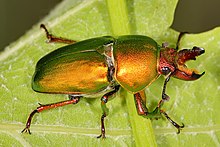Lamprima aurata
| Lamprima aurata | |
|---|---|

| |
| Adult male | |

| |
| Adult female | |
| Scientific classification | |
| Domain: | Eukaryota |
| Kingdom: | Animalia |
| Phylum: | Arthropoda |
| Class: | Insecta |
| Order: | Coleoptera |
| Family: | Lucanidae |
| Genus: | Lamprima |
| Species: | L. aurata
|
| Binomial name | |
| Lamprima aurata Latreille, 1817
| |
| Synonyms | |
|
Lamprima cuprea Latreille, 1817 | |
Lamprima aurata, the golden stag beetle, is a species of beetle in the family Lucanidae. In Tasmania, this species is referred to by the common name of Christmas beetle, a name that is normally used for beetles in the family Scarabaeidae, genus Anoplognathus.[1]
Description
[edit]This beetle has an oval, shiny body.[2] It measures between 15 and 25 mm in length. It is fairly variable in coloration, so it has been given many names by various authors.[3] The colour of the males is typically metallic golden green or yellow with colorful legs, while females may be blue, blue-green or dull brown. Females are smaller than the males, and males have larger mandibles prolonged forwards used for fighting. [4][2]
Distribution and habitat
[edit]Lamprima aurata is native to Australia and can be found in Tasmania and south-eastern mainland Australia in dry sclerophyll forests.[2]
Of the five species in the genus Lamprima, only two occur on the Australian mainland: L. aurata and the closely related L. imberbis, which live in northeastern New South Wales.[3]
Biology
[edit]The larvae are sapro-xylophagous and will spend two years feeding on rotting logs.[1][2] Adults are free-flying and will move about on the ground during the day and drink the nectar of flowers, especially eucalypts.[2] Males can be found on rotting logs defending their territory.[2]
Gallery
[edit]-
Golden stag larva
-
Illustration of male by Des Helmore
References
[edit]- ^ a b "Christmas beetle-mania is in full swing and their traits may surprise you". www.abc.net.au. December 18, 2018.
- ^ a b c d e f "Lamprima aurata Latreille, 1817, Golden Stag Beetle". Museum Victoria. Retrieved 29 December 2021.
- ^ a b C.A.M. Reid, K. Smith, M. Beatson (2018) Revision of the Genus Lamprima Latreille, 1804 (Coleoptera: Lucanidae). Zootaxa. 4446(2); 151–202. doi:10.11646/zootaxa.4446.2.1
- ^ "Golden Stag Beetle (Lamprima aurata)". Beetle Identifications. Retrieved 29 December 2021.
External links
[edit]Text is available under the CC BY-SA 4.0 license; additional terms may apply.
Images, videos and audio are available under their respective licenses.


